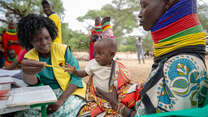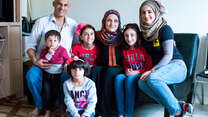Authors: Shiferaw Dechasa Demissie, Tracey Chantler, Emilie Karafillakis, Heidi Larson, Lilian Kiapi, Petros Gebrekirstos, Siraj Mohammed, Bersabeh Sile, Samuel Wodajo, Naoko Kozuki, Comfort Olorunsaiye, Justine Landegger
Background
Globally, one in five children does not receive their full course of immunizations, leaving them at risk of vaccine-preventable diseases. In Ethiopia, the situation is even worse, with a national average of only 37% coverage for pentavalent 3 (diphtheria-tetanus-pertussis-Heamophilus influenza type B-hepatitis B) vaccine, where 13% of infants received no vaccines at all. This project and accompanying evaluation particularly focuses on Benishangul Gumuz Regional State (BGRS) where about 41.7% of infants received penta3 vaccination in 2011.
Implementation
The Fifth Child Project was implemented in two woredas (districts) to help over 5,200 mothers and their children receive essential services in a timely manner, integrated with the existing Expanded Program on Immunization (EPI). The aim was to harness the support of the local community to ensure that no child was left unimmunized. Our strategy included two tailored tools: (1) the Enat Mastawesha – a color-coded calendar clarifying appointment dates and (2) a defaulter tracing tool – a paper-based register facilitating follow-up of unimmunized children. Together with ongoing mentorship for health workers, these tools are used to foster community engagement in immunization service delivery and uptake.
Evaluation
The purpose of the evaluation was to document the integration of the Fifth Child Project within the Health Extension Program in two districts in BGRS; as well as to assess the contribution of the project to improving immunization performance and to evaluate the acceptability of project tools.
Methods
Quantitative: data were obtained from the woreda-level health management information system. Penta 1 and 3, and measles vaccine coverage among children less than 1 year (Jan 2013-Dec 2016) and maternal health data (Jan-Dec 2016) were monitored by IRC in Assosa and Bambasi woredas.
Qualitative: data comprised 46 semi-structured interviews (SSIs), 6 focus group discussions, and 16 semi-structured observations of 3 kebele command post meetings and 12 home visits carried out by HEWs or HDAs.
Findings
Quantitative findings: Trends in immunization and maternal health data
Immunization coverage trends: In Assosa woreda, among 3,237 infants, penta 1 coverage increased from 65% in 2013 to 82% in 2016; penta 3 increased from 63% in 2013 to 84% in 2016 and measles coverage increased from 77% in 2013 to 79 % in 2016. In Bambasi woreda, totaling 1,971 infants, the penta 1 coverage increased from 80% in 2013 to 97% in 2016; penta 3 increased from 78% in 2013 to 88% in 2016 and measles coverage increased from 59% in 2013 to 83% in 2016. Of 2,830 defaulting children, 2,363 (84%) were identified and successfully immunised with the vaccines they had missed, exceeding the 70% target selected in the performance monitoring plan.
Post-partum family planning: The proportion of mothers using postpartum family planning in Assosa increased from 12% in January 2016 to 74% in December 2016, and in Bambasi woreda, from 18% in January 2016 to 43% in December 2016, with the majority of acceptors choosing contraceptive implants.
Qualitative findings: The Fifth Child Project was well accepted by stakeholders in both woredas. The calendar was described as a personalized reminder for mothers that reduced workload and increased demand for and timely uptake of immunization services. It was acknowledged that the defaulter tracing tool improved access to vaccination data and enabled community health workers to count and identify defaulters more effectively.
Overall, woreda health officers reported that the “Fifth Child Project” became a valuable and integral part of the existing health Extension Program.
Conclusion
Study findings suggest that the ‘Fifth Child Project’ contributed to enhancing immunization performance in two districts of Benishangul Gumuz Regional State. Hence it is vital that health policy makers and service managers, who are responsible for the HEP at regional and national level, explore with IRC how the ‘Fifth Child Project’ can be scaled up sustainably.



